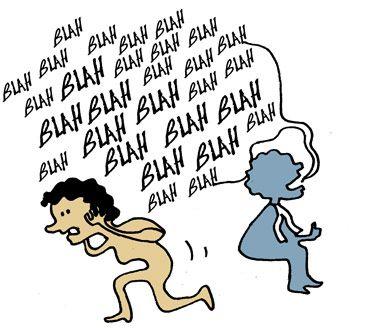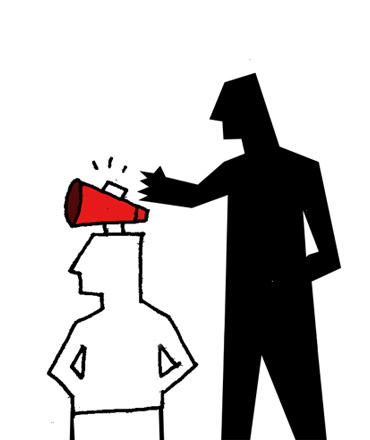Photographs: Jackal of all trades/Creative Commons Andrew Brown
Speaking is only one of the four skills we use to communicate. What are the other three? Read on to learn more...
Communicating is an essential part of being human.
We are social, co-operative creatures, and by communicating with others we share ideas and collaborate to achieve more than we could alone.
Better communication will enable us to achieve even more, and one of the places where this is most important is the place where we spend a large part -- or even most -- of our waking time: work.
Much has been written about successful communication in the workplace, and there are seemingly endless websites with information and ideas, telling you to do this, or do that.
How do you tell what is good advice?
Here are 10 key ideas to start with:
1. Be clear about how communication actually happens
Communication is not just about how you speak. Communication is an exchange.
There are four main communication skills: writing, reading, listening and speaking. Speaking is only one of the four skills we use to communicate.
When we are communicating, we spend 45 per cent of our time listening, 16 per cent of our time reading, 9 per cent writing, and only 30 per cent of the time speaking.
That means that 70 per cent of being a successful communicator is not about how we speak.
Even when we are speaking, it is important to be aware of how the communication is taking place.
Fifty five per cent of our communication is actually visual (not what we say), 38 per cent is vocal (how we say it), and only 7 per cent is verbal -- what we are actually saying.
So, what is the implication of this…?
Please click NEXT to continue reading...
The author is programme director, Kings Learning, a Bangalore-based spoken English training institute.
2. Visual communication
Photographs: Uttam Ghosh/ Rediff.com
How you appear to others makes up more than half of the message in face-to-face communication.
There are many factors involved here, including culture, gender, how other people perceive your status and their status, and the physical conditions and environment in which the communication is taking place.
In most business situations you should try to appear self-assured, positive, enthusiastic, and friendly.
In all communication, but in particular on the phone, (even though this might sound strange), put a smile on your voice -- you'd be surprised, but people can hear it if you are smiling, even on the phone!
Make the most of yourself and the visual opportunities available.
Make eye contact with your listener(s).
This helps you look self-assured (confident) and honest.
Be aware of your facial expressions. Don't frown.
Make sure that you have a positive, open expression on your face.
Be aware of the rest of your body language, too.
Think about your posture: Walk tall!
Use your hands to gesture (describe, emphasise, count, show attitude).
Look the part, and dress for the job you want, not the job you have now!
That way, people will start to think of you as a good candidate for your future job, even before you apply.
Finally, be aware of your environment -- where you are, what is around you.
Think about where your communication is taking place, and -- if possible -- control it, or manage it.
Please click NEXT to continue reading...
3. Vocal communication: Pay attention to your pitch
Photographs: Rediff Archives
It's not what you say, it's how you say it.
Just think of the many different ways we communicate using just our voice (eg volume/loudness).
We vary our tone, the way we stress a word, or the way we stress across different words.
We vary the pitch, rhythm, pace of our speech, or the way we pause.
How you sound to others can communicate 38 per cent of the message, when you are face-to-face with someone.
On the phone this can be up to 70 to 90 per cent of the message.
Make the most of your voice and how you can use it to improve your communication.
Use the correct word stress to pronounce key words clearly.
Make sure you stress the key words in each sentence, highlighting important names, facts, figures and actions for the listener.
Not too fast, not too slow -- use the right pace for your listener.
If you speak too fast, the listener won't be able to understand everything you are saying.
If you speak too slow, you may lose their attention.
Use pauses to mark the end of one idea and the beginning of the next.
A pause gives your listener a chance to catch up with what you have said, and also helps you get their attention for the next idea.
Vary your pitch.
A low pitch can help you sound in control or knowledgeable, but can also sound monotonous, too serious or bored.
A high pitch can help you sound enthusiastic, but can also sound trivial.
You need to adapt to the situation and to your audience.
Use the right intonation to show enthusiasm for what you are saying, and to connect with your listener(s).
Use the right rhythm to keep their interest.
Put it all together to draw attention to your key points.
Please click NEXT to continue reading...
4. Watch out for verbal and non-verbal cues
Photographs: Uttam Ghosh/ Rediff.com
Having said all that, what you say is also hugely important.
The right word is crucial.
It is also very important that what you say matches how you are saying it.
The perfect choice of vocabulary and sentence structure can really help your workplace communication.
Follow the KISS rule: Keep It Simple, Stupid!
Don't make it more complicated than it has to be.
Use short, simple words in 'plain English', wherever you can.
Simple words are easier for the listener to understand (so the listener can grasp your message more quickly).
Simple words normally have more impact than longer words.
Use short simple sentences, not long, complicated sentences.
Short sentences also make it easier for your listener to understand what you are saying.
They communicate with greater clarity and impact, and break your message into easily understood chunks.
A good way to remember is to follow the 5 C's in workplace communication.
Before you speak, think, and use language that is Clear, Concise, Complete, Correct, and Courteous.
And, thinking back to all the parts of communication which are non-verbal, we could add that the words you use should also be consistent with the way you are saying it.
Please click NEXT to continue reading...
5. Listen to the person speaking to you
Photographs: Uttam Ghosh/ Rediff.com
When you are listening, make sure you are communicating back to the person speaking to you.
Maintain eye contact, nod, and give short vocal signals like 'yes', 'OK', 'Uh-huh', to show that you are listening, and that you understand (even if you don't necessarily agree!).
This shows that you have received the message which the sender wanted you to receive.
There are three possible barriers to listening.
First, barriers created by the sender themselves, such as mispronunciation, poor choice of words, or inconsistency between the Visual, Vocal and Verbal communication taking place.
Second, barriers created by the listener (example: distrust or dislike for the sender, preconceived ideas, evaluating the sender not the message).
Finally, there are environmental barriers from the situation in which we find ourselves, such as noise, too much technology, distractions, discomfort, and so on.
We need to be aware of all these barriers, and do what we can to minimise them, to ensure that good communication is taking place.
So, how can you be a good listener?
Focus fully on the speaker, don't interrupt, don't judge, and show your interest.
Please click NEXT to continue reading...
6. Speak with style
Photographs: Rediff Archives
There are (at least) four different communication styles.
Being aware of them can help you to use the right style in the right situation, and to get the right message across.
Action-oriented communicators talk about achieving things.
They talk about the 'bottom line', moving ahead, decisions and achievements.
Process-oriented communicators talk about facts and figures.
They talk about policies and procedures, analysis and planning.
People-oriented communicators talk about needs and about motivation.
They talk about teamwork, values, feelings and beliefs.
Idea-oriented communicators talk about innovation and change.
They talk about new ways of doing things, concepts and possibilities.
Think about what you want to communicate, and try to adopt the right style to achieve this.
Also, think about what style is being used by the person to whom you are listening, and this will help you to understand what they want to say.
Please click NEXT to continue reading...
7. First impression, best impression
Photographs: Uttam Ghosh/ Rediff.com
First impressions are formed in the first few seconds or minutes of a communication exchange (face-to-face, on the phone, even in writing).
It is important to make the most of the opportunity.
As they say, you only get one chance to make a first impression.
When we communicate at work, we must think about how we look (the visual channel), about how we sound (the vocal channel) as well as the words we use (the verbal channel).
We are always communicating something, even if we think we are doing nothing, and this applies to the way we listen as well as to the way we speak.
Please click NEXT to continue reading...
8. Be careful while talking to your boss
Photographs: Uttam Ghosh/ Rediff.com
If you are speaking, make sure you have the message clear in your own mind.
Then choose the best way to deliver this message.
Think about possible barriers, such as 'filters' (due to age, culture etc).
Minimise 'noise' or other distractions.
Use the environment to help your communication (choose the best place and time).
Check that your intended message was understood.
If you are listening, give the speaker your full attention.
Listen! Take account of 'filters'.
Evaluate, interpret and understand the message.
Give feedback (Visual, Vocal, and Verbal) to show that you do (or don't!) understand the message.
Ask for clarification if you don't fully understand.
Clarify responsibilities and roles, or targets and objectives.
Check deadlines and time frames. Listen attentively.
Don't Say: We'll try.
Do Say: We'll do (what) by (when).
Don't Say: I can't. I don't know how.
Do Say: I'm not sure how, yet. Can you help me?
Don't Say: That's not my job.
Do Say: If our objective is to . . . then I see my responsibilities as . . . Do you agree?
Please click NEXT to continue reading...
9. Communicating with peers and subordinates
Photographs: Uttam Ghosh/ Rediff.com
When you are communicating with peers, be clear about who is responsible for what.
Offer feedback and assistance.
Check what you will need to get the job done.
Look for win-win solutions, and try to avoid conflict.
Don't Say: That's your work and this is mine.
Do Say: How can we work together?
Don't Say: My work is more important. I need the resources more than you do.
Do Say: This is a high priority project. I'm afraid that it will require more resources...
Don't Say: That report is poorly written.
Do Say: I've got some thoughts about how you could improve the report. Would that be helpful?
When you are communicating with subordinates, be clear about your expectations.
Give subordinates a chance to decide some of their goals and objectives, and to make some decisions about their work.
Be clear about limits on resources, time and money.
Give a lot of feedback.
If there is conflict or friction, deal with it quickly. Listen actively and respond with understanding.
Don't Say: This is what I want you to do and this is how I want you to do it.
Do Say: This is the goal, how do you think it can be achieved?
Don't Say: That's not my problem. You figure it out.
Do Say: How can I help?
Don't Say: I know you're feeling sick but I have a business to run.
Do Say: Oh, I am sorry you're not feeling well. Do you think you feel well enough to help us out? You know how busy we are. But...
Please click NEXT to continue reading...
10. Communicating with clients/customers
Photographs: Uttam Ghosh/ Rediff.com
When you are speaking to clients or customers in person, think about their interests and needs, not yours.
Don't try to sell a product or service: sell what the product or service can do for the client or customer.
Ask questions. Listen without interrupting.
Don't Say: Buy this, it's a good price.
Do Say: I'm sure you will find this a very reasonable price.”
Don't Say: You need this...
Do Say: This is a very useful item because...
Don't Say: Do you want to buy it?
Do Say: Are you interested in buying...
When you are speaking to clients or customers on the telephone:
Don't Say: You hold on.
Do Say: Just one moment, please.
Don't Say: Just a moment...
Do Say: Would you mind holding for a moment?
Don't Say: You wait a while.
Do Say: One moment please. Or I'll be back in a moment.
Don't Say: Not here. Call back.
Do Say: I'm afraid (who) is not in (place) at the moment. Can I take a message?
ALSO READ Top 10 e-mail blunders Indians make











Comment
article